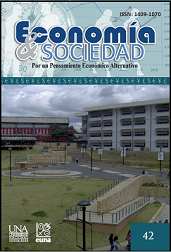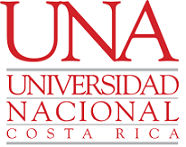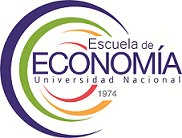Territorial Competitiveness Index applied to Heredia cantons in Costa Rica
Keywords:
Territorial Competitiveness Index, local government, territorial competitiveness, Heredia cantons, location of SMEs.Abstract
The Territorial Competitiveness Index in Heredia cantons is assessed in this paper using a weighted index including five basic components: economic-business, socio-demographic, infrastructure, local governance, and environmental. Results help identify competitive strengths and weaknesses of each canton, which provides valuable information to entrepreneurial investors in order to assess the permanence or opening of a productive activity in the territory and to local authorities in order to identify variables to improve. The Territorial Competitiveness Index classifies cantons by the level of competitiveness associated and identifies the variables that explain such competitiveness and the location of SMEs. Results are compared with other methodologies used in the country to measure socio-economic aspects, human, and local government development, allowing for a broad view of the particular competitive aspects related to each canton.
References
Arias, R. y Sánchez, L. (2010). Competitividad, especialización y mercado laboral, en el cantón de Pérez Zeledón: Un análisis de economía Regional. IICE UCR. Costa Rica.
Banco Mundial, Corporación Financiera Internacional. (2010). Doing Business 201.0 Banco Mundial. Washington, Estados Unidos.
Barahona, C., Elizondo, J., Andrey, M. (2011). Evaluación de sitios web del gobierno y municipalidades de Costa Rica 2009. INCAE Business School. Costa Rica.
Begg, L. (2002). Urban Competitiveness, policies for dynamic cities. The Policy Press. Great Britain.
Cabrero, E., Orihuela, I., Ziccardi, A. (2003). Ciudades competitivas-ciudades cooperativas: Conceptos claves y construcción de un índice para ciudades mexicanas. Documento de trabajo 139, División de Administración Pública, CIDE. México.
CGR. (2010, enero). Análisis y opinión sobre la gestión de los gobiernos locales en el periodo 2010. Recuperado de http://www.asamblea.go.cr/Informes_de_la_Contraloria/Informes%202011/h-%20informes_agosto_2011/Analisis%20y%20opini%C3%B3n%20sobre%20la%20gesti%C3%B3n%20de%20los%20Gobiernos%20Locales%20en%20el%20per%C3%ADodo%202010.pdf
CGR. (2010, marzo). Índice de gestión municipal 2010. Contraloría General de la República. San José, Costa Rica.
Fundación CAATEC. (2009). Barómetro Cisco: VII medición de la penetración de Internet de banda ancha en Costa Rica. Costa Rica: EUNED.
IFAM (2003). Serie de cantones de Costa Rica. Instituto de Fomento y Asesoría Municipal. Costa Rica.
INA. (2010). INA en cifras 2010. Instituto Nacional de Aprendizaje San José, Costa Rica.
Krugman, P. (1996). Making sense of the competitiveness debate. Oxford Review of the Economic Policy. Great Britain.
Liedtke, U. (2008). Benchmarking Territorial Competitive. Proyecto modernización y descentralización. (PROMODE) de la Cooperación Técnica Alemana (GTZ). Documento de trabajo. Buenos Aires, Argentina
MIDEPLAN (2007). Índice de desarrollo social 2007. Recuperado de http://www.mideplan.go.cr/images_sides/stories/mideplan/analisis_desarrollo/resumen_ejecutivo_ids_2007.pdf
MINAET (2011). Ranking cantonal de brecha digital. Ministerio de Ambiente, Energía y Telecomunicaciones. Cosa Rica.
Sifuentes, N., Violeta, A. y Ponce, M. (2008). Estadística inferencial aplicada. Universidad Nacional Mayor de San Marcos. Lima Perú.
PNUD. (2011). Anexo estadístico del atlas del desarrollo humano cantonal de Costa Rica 2011.
Programa de las Naciones Unidas para el Desarrollo (PNUD); Escuela de Estadística, Universidad de Costa Rica. PNUD 1 edición. San José, Costa Rica.
PNUD. (2011). Atlas del desarrollo humano cantonal de Costa Rica 2011. Programa de las Naciones Unidas para el Desarrollo (PNUD); Escuela de Estadística, Universidad de Costa Rica. PNUD 1 edición. San José, Costa Rica.
Porter, M. (1995). The competitive of the inner city. Harvard Bussiness Review. USA
Porter, M. (1996). Competitive Advantage, Agglomeration Economics, and Regional Policy. International Regional Science Review. USA
Ramírez, J., Parra, R. (2009). Escalafón de la competitividad de los departamentos en
Colombia, 2009. CEPAL Estudios y perspectivas serie 21.
Roberts, J. (2004). La empresa moderna: Organización, estrategia y resultados. Barcelona: Antoni Bosch.
RTI International (2009). Índice de competitividad municipal 2009, El Salvador. Agencia de los Estados Unidos para el Desarrollo Internacional. Estados Unidos
Schwab, K. (2010). The Global Competitiveness Report 2010–2011. World Economic Forum. Geneva, Switzerland.
Sobrino, J. (2002). Competitividad y ventajas competitivas: Revisión teórica y ejercicio de aplicación a 30 ciudades de México. El Colegio de México, México.
Subsecretaría de Desarrollo Regional y Administrativo (2009). Informe índice de competitividad regional. Ministerio del Interior, Ministerio de Planificación e Instituto Nacional de Estadística. Chile.
Tello, M. (2010). Del desarrollo económico nacional al desarrollo local: Aspectos teóricos.
Revista CEPAL 102, 51-67.
The Economist (2012). Benchmarking global city competitiveness. The Economist Intelligence Unit Limited. London. United Kingdom.
Ulate, A., Chaves , G., Maroto, M. (2009). Índice de competitividad cantonal: Costa Rica. Promotora del Comercio Exterior de Costa Rica; Observatorio del Desarrollo, Universidad de Costa Rica. PROCOMER, San José, Costa Rica.
Van Dijk, M., y Sandee, H. (2002). Innovation and Small Enterprises in the Third World. Massachusetts: Edwrd Elgar Publishing, Inc.
Downloads
Published
How to Cite
Issue
Section
License
This publication is subject to the Creative Commons License; therefore, its attributions and restrictions must be respected.
Authors publishing in this Journal accept the following conditions:
- Authors retain copyright ownership and give the Journal first publication right of the paper, which is registered with the Creative Commons Attribution-NonCommercial-ShareAlike 4.0 International License. This license allows third parties to use the published work provided it is sourced as firstly published in this Journal.
- Authors may enter into other independent and additional contractual agreements for the non-exclusive distribution of the article published in this Journal (e.g., to be included in an institutional repository or published in a book) provided it is clearly stated that the work was published in this Journal for the first time.
- Authors are allowed and recommended to publish their work on the Internet (for example, on institutional or personal pages) before and during the review and publication process, as it can lead to productive exchanges and a greater and faster dissemination of work published.

The Economía & Sociedad Journal, published by Universidad Nacional, is licensed under a Creative Commons Reconocimiento-NoComercial-CompartirIgual 4.0 Internacional License. Based on http://www.revistas.una.ac.cr/index.php/economia.








